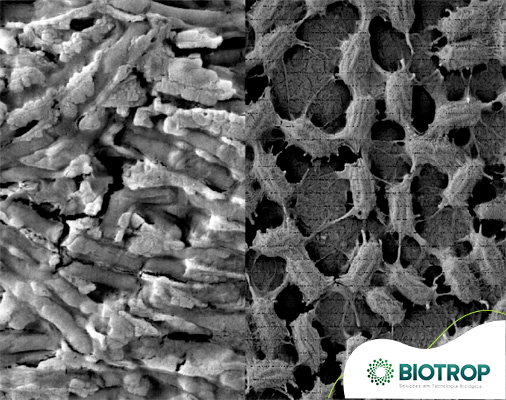Biological nematicides: understand what they are, management strategies, advantages, disadvantages, and more!
Countless factors may influence crop productivity, including nematodes.
The presence of nematodes in your property may cause significant losses.
Therefore, understanding alternative management methods as well as how to perform them on your property is crucial to minimize crop damage.
In order to help you, we have selected some important information about biological nematicides as well as how they can be part of the integrated management strategies on your farm. Check it out!
What are biological nematicides?
Biological nematicides are important tools when it comes to biological control because they are bioproducts.
These products derive from fungi and/or bacteria that act as bio-controlling agents of plant nematodes.
These agents are able to capture, parasitize, disorient, and even paralyze nematodes at different development stages.
An example of microorganism used as a biological nematicide is Bacillus spp., which acts as an antagonist of nematodes, preventively protecting some cultivated plants and stimulating plant growth in general.

Bacillus subtilis
Bacillus subtilis (Source: Itamar Soares de Melo)
Nevertheless, certain questions on the implementation of biological management on your property are common.
With that in mind, we have selected some information on biological nematicides. Check it out!
Efficiency of bionematicides in nematode management
Firstly, planning a management approach is crucial for a successful crop production.
Avoiding continuous use of products with the same mode of action and adopting integrated management practices is important when it comes to controlling nematodes efficiently.
The control measures below are also important:
- Use of healthy seeds and seedlings;
- Crop rotation with non-host species;
- Green manuring with non-host species;
- Use of cultivars that are resistant or tolerant to nematodes.
Finally, the use of biological nematicides can be an excellent alternative.
Studies carried out at Universidad de Pinar del Río showed that the use of bionematicides significantly reduced populations of Meloidogyne ssp. as time went by.
Likewise, researchers from other research institutes found similar results for tomatoes, soybeans, and beans, in which the use of biological nematodes showed high efficiency when it comes to controlling nematode eggs.

Cysts of soybean cyst nematode (Source: Aleandro da Silva Santino)
Always keep in mind that the integrated use of different control methods will result in higher efficiency when it comes to controlling nematodes.
Therefore, work on a management plan and take into account the adoption of biological control on your property if you do not use it.
However, before purchasing any products, either biological or chemical ones, be aware of the nematode species on your farm.
Take soil samples and have them tested for nematodes.
If you have any questions, you can check the Manual – Guidelines for soil and root sampling for nematodes.
Also, pay attention to the product’s specificity: for which nematode species and crop it is registered.
The registration of nematicides can be found on the Ministry of Agriculture, Livestock and Food Supply (MAPA) website, Agrofit.
Keep in mind that it is crucial that you consult an agricultural engineer/agronomist so you can plan the management and position products successfully, according to your needs.
Biological nematicides: advantages and disadvantages
Just like any other product, bionematicides have advantages and disadvantages, and you need to understand them before adding these products to your agricultural planning, thus avoiding future problems.
Advantages
- Cost
Lower cost compared with chemical nematicides.
- Application
Biological nematicides are easy to handle, ensuring lower risk of contamination to applicators.
- Residue
The products do not leave residues in the soil; therefore, they do not contaminate the environment.
- Availability
Unlike chemical products, several bionematicides are manufactured in Brazil, costs in local currency, and high availability.
- Efficiency
Losses in control efficiency after several applications have not been reported yet (there is no history of resistance). They control a number of nematode species efficiently.
Disadvantages
- Compatibility with agrochemicals
Some bionematicides may not be compatible with insecticides used for seed treatment; therefore consult the manufacturer before using it.
BIOTROP highly values compatibility and works with products that have this characteristic.
- Caution during Transportation and Storage
Because they are living beings, careful transportation and storage are crucial. Always choose cool places so as not to lose the viability of the product.
- Application
The weather is a determining factor for application, since stress caused by temperature and humidity can reduce the viability of the product.
Therefore, opt for products that do not need to be refrigerated and have a shelf life of at least two years, such as BIOTROP’s products.
Conclusion
Considering your efforts as growers, you cannot lose productivity due to the presence of nematodes.
Therefore, understanding alternative management methods is crucial to perform integrated pest management on your property.
In this article, you could learn what nematicides are, their efficiency, and how to add them to your crop management plan.
In addition, you could understand the advantages and disadvantages of using bionematicides on your property.
Do you have problems with nematodes? Did you know any biological nematicides? Leave your comment below!
Assuntos Relacionados:
Artigos relacionados a Nematoides
Nematicida Biológico da Biotrop.
Chegou o nosso poderoso bionematicida. Conheça o Furatrop!

